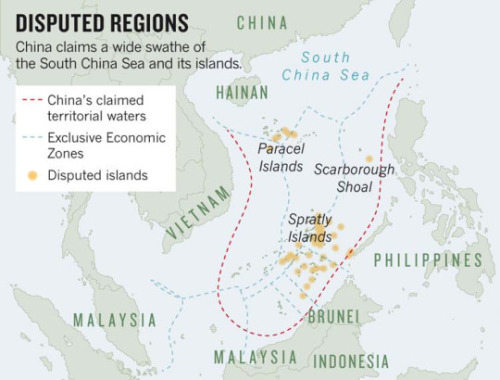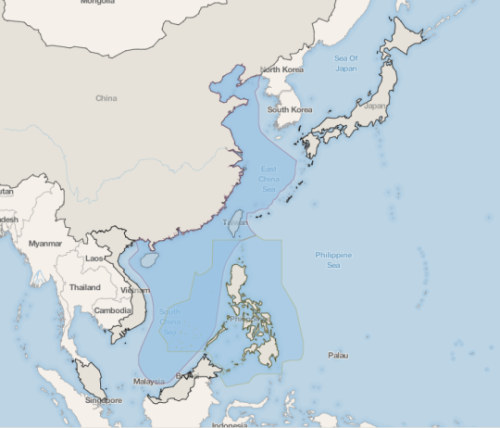David versus Goliath, Philippines versus China: History in the Making
Tomorrow, at 5:00 pm (11:00 am CEST), the Permanent Court of Arbitration, the world’s oldest intergovernmental organization in settling disputes between countries (founded in 1899), is set to issue their official ruling on the Philippine case against China’s 9-dash line claim on most of South China Sea, under the rules of the UN Convention on the Law of the Sea (UNCLOS), a document signed by both the Republic of the Philippines and the People’s Republic of China.
For those who do not know, the 9-dash line is a controversial demarcation line used by China to mark its claim to territories and waters in the South China Sea, encompassing 3.5 million square kilometers of sea, virtually the entire South China Sea. The maritime claim include the Scarborough Shoal (Panatag Shoal), the Paracel Islands and the Spratly Islands, island groups and rock formations contested by several other countries including the Philippines. Panatag Shoal is merely 355 kilometers from Manila, far beyond China’s 200 nautical miles of Exclusive Economic Zone (EEZ) and well within the Philippines’, as prescribed in the UNCLOS.

*Map above from Council on Foreign Relations (CFR)
When the Philippines filed the case on January 22, 2013, it was the first time that a legitimate complaint regarding the invalidity of the 9-dash line was submitted to an international body. It is, undoubtedly, a game changer.
To further bolster its claim, the Philippines renamed “the maritime areas on the western side of the Philippine archipelago” that includes areas such as “ Luzon Sea as well as the waters around, within and adjacent to the Kalayaan Island Group and Bajo De Masinloc, also known as Scarborough Shoal” as West Philippine Sea. It must be noted that West Philippine Sea is just a part of the 9-dash line and is not its entirety. Hence, the Philippine move to invalidate the 9-dash line claim also helps out neighboring countries with overlapping claims in the 9-dash line that does not overlap with the Philippines, thus promoting peace and security in the region.
The international community expects a favorable ruling for the Philippines, as it will definitely set into stone an international recognition of the rule of law on the planet’s oceans. Many international observers and geopolitical analysts see this as a David versus Goliath: a small nation of 100 million with weak military might such as the Philippines, versus a nation of 1 billion with a well-funded and strong military and navy like China. The battle so far have been fought not by force of arms (because clearly, the Philippines would be on the defeated end if that was the case) but by arbitration of an impartial and internationally recognized body such as the Arbitral Tribunal.
The goal has been to invalidate China’s preposterous claim of the 9-dash line, which even by the looks of it, is glaring. The country’s filing of the case was applauded by the international community, calling it a “stroke of genius.” It is because the Arbitral Tribunal basically has no mandate to even tackle issues on sovereignty. That’s why when the Philippines initiated its legal claim on January 22, 2013 to the Arbitral Tribunal, and submitted its 4,000-page memorial on March 30, 2014, it “repackaged” its case in such a way that the center of the argument is maritime delimitation and entitlement.
If the Philippines wins (which is more likely), other nations with contesting claims on maritime zones China is claiming in the South China Sea can use the ruling as leverage. And if these nations would use UNCLOS as leverage, they will most definitely follow it and perhaps, like what the Philippines and Indonesia did in May 2014 when the two nations resolved and ended the 20-year dispute over their overlapping maritime zones, these countries will follow suit.
And China knows this.
If China continues to ignore the arbitration and defy the ruling to be delivered tomorrow, continuing in militarizing South China Sea and establishing artificial islands, then China’s bid on the leadership of the region will seriously be compromised. Of course, there is no official body to enforce the verdict. And as we have seen with the way China is behaving, they will continue to push the envelope, until the Philippines gives in. As analyst Richard Javad Heydarian said, “the arbitration case is binding, but not enforceable unless the global powers step up to the plate.”
To study more on this issue, I recommend the following articles:
1. The Heart of the Dispute over the West Philippine Sea by Matikas Santos
2. Philippines vs. China: International Law or Rule of the Jungle? By Richard Javad Heydarian
3. Statement of former Philippine Foreign Affairs Secretary Albert del Rosario before the Permanent Court of Arbitration
4. U.S. State Department’s Official Position Paper on South China Sea (released on December 5, 2014)
5. People’s Republic of China’s Official Position Paper on South China Sea (released on December 7, 2014)
6. Interactive Map and Timeline: China’s Maritime Disputes by the Council on Foreign Relations (CFR)
7. Ang West Philippine Sea: Isang Sipat by DFA/PCDSPO 2015
8. Three possible scenarios in South China Sea arbitration ruling by Philippine Supreme Court Justice Antonio Carpio
In all these, the Philippines has gained allies in its David ‘n Goliath legal battle mainly because the Philippine cause in this case is FAIR and RIGHT. As the Memorial filed to the Tribunal indicated, the Philippines had 17 years of bilateral negotiations with China, exhausting all diplomatic channels to no avail. Yet China has never budged nor conceded to meet the Philippines halfway. What was more glaring is the fact that with the fast construction of artificial islands and military outposts in contested areas way within the Philippines’ Exclusive Economic Zone (EEZ), China seems resolute in its position, guided by a revisionist view of history saying that the Scarborough Shoal, among others, is theirs by “historic right.” (I will tackle this in my next post).
War is out of the question. Even in our very own Constitution, we have renounced war and expansionism as instruments of foreign policy. But when our country is being forcibly challenged by another, we Filipinos, beyond allegiances of race and nation-states, should not hesitate to defend not only what is ours, but what is right and fair to all.

*Screenshot from CFR, the 9-dash line claim of China juxtaposed with Philippine claim.
*Erratum: Apologies. The post earlier erroneously indicated that the announcement of the ruling would be made at 11:00 am local time tomorrow. This has been corrected to 5:00 pm local time, in accordance with the actual official press release of the Permanent Court of Arbitration.
Photos above belong to their respective owners.
(1) An old postcard of the Peace Palace (Vredespaleis), as it looked like on 18 August 1913. The Peace Palace, located at The Hague, Netherlands, is the home of the Permanent Court of Arbitration, built in 1913 for the international body. In 1922, it also became the home of the International Court of Justice.
(2) Former Philippine Foreign Affairs Secretary delivers his speech before the Arbitral Tribunal in the Peace Palace (July 2015), from the Philippine Daily Inquirer. Take note of the vacant seats on the right side, intended for the Chinese delegation. China ignored the call of the Arbitral Tribunal to represent their position, citing that the Tribunal has no jurisdiction in the case.
(3) The Philippine delegation that presented the country’s case in the Arbitral Tribunal, composed of high-level representatives from the three separate branches of Philippine government: Executive, Legislative, and Judiciary.
104 Notes/ Hide
sillysilkyselkie-blog liked this
yasu-gyaru liked this
queerhistorymajor reblogged this from indiohistorian
worclip liked this
shibe-seer liked this
sorrowfulevenunto liked this
redefinetheclassics liked this
eaglesforthecup1 liked this
 wltch reblogged this from indiohistorian
wltch reblogged this from indiohistorian aurumxxx liked this
pizzafacee liked this
kraysee liked this
swablu liked this
a-proud-fangirl reblogged this from claviclez
claviclez reblogged this from indiohistorian
 ineffable-resplendence liked this
ineffable-resplendence liked this hanananamiya liked this
withmyteam liked this
 sumflora liked this
sumflora liked this kyeru liked this
 micie1o liked this
micie1o liked this redvxlvts-blog liked this
 faky reblogged this from indiohistorian and added:
faky reblogged this from indiohistorian and added: @2lalisa
ohmarbeline liked this
 confusion-and-cake liked this
confusion-and-cake liked this coffeebreakhaven reblogged this from indiohistorian
boopology reblogged this from indiohistorian
jack4x liked this
lessonfromtheleaves liked this
 tokiowie reblogged this from indiohistorian
tokiowie reblogged this from indiohistorian feldlerche reblogged this from hanananamiya
feldlerche liked this
hanananamiya reblogged this from indiohistorian
heart-brekker reblogged this from indiohistorian
 lawiizhou-blog liked this
lawiizhou-blog liked this 41blocks reblogged this from jeffreybower
moggy-mog liked this
gecgec reblogged this from themomentstealer
biseksuwal liked this
daegupan reblogged this from indiohistorian
- Show more notes










